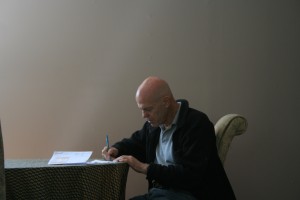Yeshiva mizrachit is hegemonic. Of course, not everybody adopts it, and there are those who positively reject it. Certain groups of Jewish citizens from the pre-state yishuv, as well from today’s state, can be singled out for not practicing yeshiva mizrachit.
Written By Gideon Aran
In the past they were the bourgeois immigrants from Germany and Poland (the Fourth & Fifth aliyot), and more recently they include immigrants from the former Soviet bloc. The former described yeshiva mizrachit as primitive and impolite; the latter see it as infantile and ostentatious.
Throughout the years, however, there has been another Jewish sector in Israel that has consistently refrained from yeshiva mizrachit, namely the local ultra-orthodox, the Israeli Haredim. The latter are unable, or unwilling, to sit like that. Indeed, the Haredim have never been “caught” sitting yeshiva mizrachit. Systematic observations and interviews confirm the incompatibility between Haredi-ness and yeshiva mizrachit. This incontrovertible fact is the starting point for the present research on the Haredi body. The issue of Haredim and yeshiva mizrachit will also close this research report.
Yeshiva mizrachit is quite conspicuously absent from the Haredi bodily repertoire. In those rare instances where yeshiva mizrachit is called for or even imposed on the Haredi, one cannot mistake the awkward and strained way in which he assumes the posture. The low-seated Haredi body then obviously betrays an alienation, and even internal resistance. This reluctance is usually accompanied by an apology, an effort to rationalize such a dissonant act by representing it in terms of an exception. In this way Haredim imply that one must not mistakenly interpret their act as trivially undertaken. After all, it is fundamentally forbidden for all sorts of reasons, including a prohibition on hand, leg and even finger positions that incorporate any kind of crossing-over of limbs, because they recall the form of the Christian cross.
Describing and analyzing bodily practices, as well as images and beliefs about the body, is instrumental to better understanding various Jewish social groups – we shall call them here body groups, or groups of a particular sitting posture – and their cultural and political context. Thus, as indicated before, yeshiva mizrachit has been an index for Zionist patriotism and statism; it signified the charismatic center of society. Yeshiva mizrachit can be a factor in recruiting and integrating its practitioners into hardcore Israeliness, but can equally function as an exclusionary mechanism: those who do not adopt yeshiva mizrachit are deprived of legitimacy and privileges and are relegated to the periphery of society.
Civil discourse in Israel is militaristic, and, by extension, masculine, a point which has been widely discussed. It may be added that the discourse of Israeliness is also a bodily one. Owing to the centrality of the body in Israeli discourse, disabled people, among others, are forced into being lower class citizens. Similar reasons play their part in making the Haredim a marginal group with dubious status. A widespread perception in the Israeli pubic identifies the Haredi body as “other”, and also as defective, grotesque and contemptible.
The Haredi body has a distinct self-image, as well as a remarkable cultural and political public presence. Is there also a unique, objective, tangible actuality – Local Biology – hiding behind all this? Are we discussing here issues of behavior and awareness alone, or are we also examining ipso facto a singular physicality?
What are the presumably two-way relations between the social and religious perceptions of the Haredi body and the corporeal one? Even if there is such a thing as the Haredi body, what is it that marks it out and distinguishes it from other bodies, especially from the contrasting Zionist body, and the traditional Jewish body that preceded it? What else can be said about the Haredi body, not necessarily as a genetic given, but rather as a Re-formed Body – an ultra-orthodox artifact, a religiously synthetic product, programmed and disciplined? And finally, in what sense is the Haredi body actually Jewish?
Taken from “Denial Does Not Make The Haredi Body Go Away Ethnography of a Disappearing (?) Jewish Phenomenon”, By Prof. Gideon Aran



